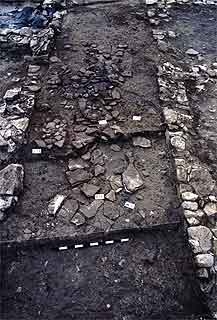- Home
- Architecture and settlement
- Settlement I (1st agglomeration)
- The streets and houses
Diverse materials (stones of various sizes, fragments of dolia and amphorae) were regularly incorporated into the street surfaces in order to facilitate circulation.
The streets were approximately 3 meters wide. The rounded angles of some islets and the protecting cornerstones of the houses show that they were clearly used for the circulation of carts. No streets were paved, but diverse materials (stones of various sizes, fragments of dolia and amphorae) were regularly incorporated into their surfaces in order to facilitate circulation. Along with domestic waste, these fillings served to raise the ground level of the streets, while that of the huts remained stable, or was sometimes lowered by repeated cleanings. The doorways of the houses were thus raised in order to prevent rainwater from entering.
As at other sites in Provence (e.g. Martigues), the small size of the habitations led the occupants to use part of the street as an extension of the house. This explains the fireplaces that have been found outside the structures, close to doors.
Jar bottoms on a house floor.
Several types of remains indicate that these buildings served as habitations: fireplaces, ceramics, metal objects, and small areas paved with flat stones that served to isolate perishable goods. In contrast to settlement 2, there are no presses and the storage of foodstuffs seems to have been limited to a few jars. These were clearly farmers with very low production levels.

